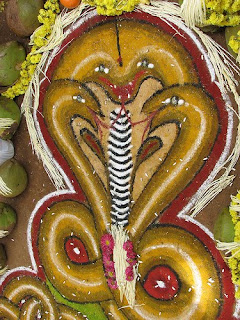KOLLUR
The Mookambika shrine at Kollur is one of the most revered pilgrimage centers in Karnataka (and in Kerala). It is located at a distance of 147 km from Mangalore. The nearest railhead is Udupi, and it is well connected with tourist centers such as Mangalore and Shimoga in Karnataka and Kannanur in Kerala.
Kollur is regarded as one of the Seven Muktislala pilgrimage sites in Karnataka which are (kollur), Udupi, Subrahmanya, Kumbasi, Kodeshwara, Sankaranarayana and Gokarna.
Kollur is known for its association with Aadi Sankara. Mookambika is said to have appeared before Aadi Sankara here, and he is said to have installed her image at this shrine. There is a room near the sanctum - enshrining the Sankara Simhasanam which is regarded as the very spot where he meditated and had a vision of Mookambika. Mookambika is regarded as a manifestation of Shakti, Saraswathi and Mahalakshmi. The Kudashadri hill houses sites such as Ambavanam and Chitramoolam where Adi Sankara is believed to have meditated.
Deities: The swayambhu lingam in front of the image installed by Adi Sankara, has a golden rekha (line) approximately at the center, and is considered to be a Shiva-Shakti manifestation. The image of Mookambika is in a seated posture, bearing the conch and the discus. Also enshrined near this image are those of Mahakali and Saraswathi. There are also shrines to Veerabhadra, Subramanya, Naga, Vinayaka and Anjaneya. Veerabhadra is worshipped first by devotees before entering the shrine to Mookambika.
Legends: Kollur is referred to in the Skanda Purana. It was originally known by the name Maharanyapura. It is said to have been home to several sages and yogis. A sage by name Kola was advised to worship Shakti at Kollur. A lingam appeared on its own accord then at Kollur, and Shiva requested Kola Rishi to worship it and that in due course Shakti would manifest herself as Mahalakshmi there. The name Kolapura eventually changed to Kollur.
Further, the ravages of the demon Kamha bothered the ascetics of Kollur. Upon being requested by Kola and other sages of Kollur, Shakti cursed the demon to become mooka or dumb. Undaunted, the demon continued his atrocities, and an enraged Devi vanquished him. Upon vanquishing Mookasura, Devi is believed to have merged into this self manifested Lingam in this temple. 24 km from Kollur is Maarana Ghat where it is believed that the demon Mookasura was destroyed. In the temple at Maarana Ghat, there is a Sri Chakra symbolizing Devi.
A trek to the peak of the Kudashadri peak and a hike to the Govinda Theertha waterfalls are noteworthy trips from Kollur.
The temple has been patronised by ancient Hindu Kings and several parts in it are still believed to contain valuable treasures. This was the state temple for the Nagara or Bednore Rajas and many jewels now adorning the idol are said to have been presented by them and by their overlords of Vijayanagar. During the Mahratta raids in this district in the 18th century these freebooters are believed to have carried away gold, silver and gems worth crores of rupees.












